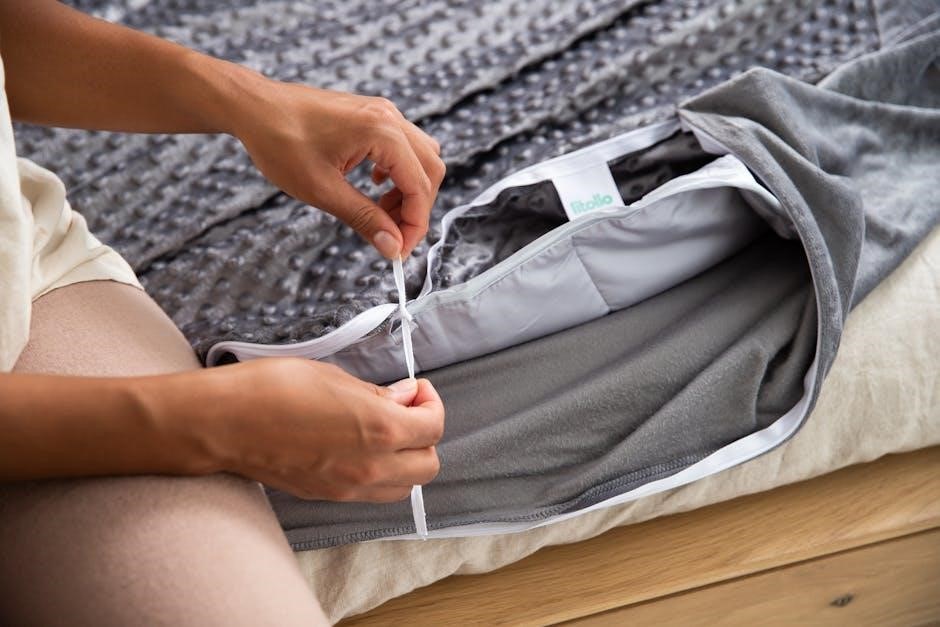A weighted blanket is a specially designed blanket filled with weighted materials, typically recommended to be 10% of the user’s body weight, designed to provide deep pressure stimulation for improved sleep, reduced anxiety, and pain relief, offering a calming, grounding sensation that promotes relaxation and comfort․
1․1 What is a Weighted Blanket?
A weighted blanket is a therapeutic blanket designed to provide deep pressure stimulation․ Typically weighing between 5-12% of the user’s body weight, it contains weighted materials like polypropylene pellets or glass beads․ The added weight creates a calming, grounding sensation that mimics a gentle hug, promoting relaxation and reducing stress․ It is often used to improve sleep quality, ease anxiety, and offer comfort for individuals with sensory processing needs or chronic pain, making it a popular tool for both therapeutic and everyday use․
1․2 Brief History and Evolution
The concept of weighted blankets traces back to occupational therapy practices in the 1990s, where deep touch pressure was used to calm sensory-seeking individuals․ Initially, these blankets were homemade or custom-made, often filled with rice or sand․ In the 2010s, companies began mass-producing weighted blankets with safer materials like polypropylene pellets, making them more accessible․ Their popularity surged around 2017-2018, as they became a mainstream solution for sleep, anxiety, and sensory integration, evolving into a diverse market with various sizes, materials, and weights to suit different needs and preferences․

Benefits of Using a Weighted Blanket
Weighted blankets provide deep pressure stimulation, improving sleep quality, reducing anxiety, and easing chronic pain through a calming, grounding effect, enhancing overall well-being naturally․
2․1 Improved Sleep Quality
Weighted blankets enhance sleep quality by providing deep pressure stimulation, which promotes serotonin and melatonin production, helping individuals fall asleep faster and stay asleep longer․ This grounding effect reduces restlessness and insomnia, creating a calming environment for deeper, more restorative sleep․ Users often report improved sleep duration and better overall sleep quality, making weighted blankets a popular choice for those seeking natural sleep solutions without medication․
2․2 Reduced Anxiety and Stress
Weighted blankets reduce anxiety and stress by applying deep pressure stimulation, which increases serotonin and melatonin levels, promoting relaxation․ The weighted blanket mimics a comforting hug, reducing cortisol levels and creating a sense of safety․ This grounding effect helps calm the nervous system, easing anxiety and stress․ Many users report feeling more relaxed and centered, making weighted blankets a popular tool for managing anxiety and stress naturally without medication․
2․3 Relief from Chronic Pain
Weighted blankets offer significant relief from chronic pain by applying deep pressure stimulation, which releases serotonin and endorphins, the body’s natural pain relievers․ The weighted material provides a grounding effect, reducing discomfort and stiffness while promoting relaxation․ For those suffering from chronic pain, weighted blankets can be a natural, non-invasive solution to alleviate symptoms․ Many users report reduced pain intensity and improved mobility, making weighted blankets a recommended tool by therapists for managing chronic pain effectively․
2․4 Enhanced Sensory Integration
Weighted blankets can enhance sensory integration by providing deep pressure stimulation, which helps regulate the nervous system․ This grounding effect calms the body, reducing sensory overstimulation and anxiety․ The weighted material encourages proprioceptive input, making it easier for the brain to process sensory information․ For individuals with sensory processing disorders, weighted blankets offer a natural way to improve focus, reduce restlessness, and promote emotional regulation, making them a popular tool for enhancing sensory integration and overall comfort․

Choosing the Right Weighted Blanket
Selecting the right weighted blanket involves considering weight, size, and material․ Aim for 10% of your body weight, choose a size that fits your body, and opt for materials that suit your preferences, ensuring comfort and effectiveness for improved sleep and relaxation․
3․1 Understanding Weight Recommendations
The ideal weighted blanket weight is typically 10% of the user’s body weight, offering a calming, grounding sensation․ However, recommendations can range from 5% to 12%, depending on personal comfort, medical conditions, and body type․ Lighter weights are often preferred for smaller individuals or those with mobility issues, while heavier weights may suit larger individuals or those seeking deeper pressure stimulation․ Always choose a weight that feels comfortable and safe, avoiding excessive heaviness to ensure proper breathing and movement․ Consulting a therapist can help determine the most suitable weight for specific needs․
3․2 Selecting the Right Size and Material
Choosing the correct size ensures the weighted blanket provides optimal coverage without overwhelming the user․ The blanket should fit the person, not the bed, for maximum comfort․ Materials vary, with popular options including minkie, sherpa, wool, polar fleece, and cotton, each offering unique benefits like softness, warmth, or breathability․ Consider personal preferences, climate, and sensory needs when selecting fabric․ Lighter materials suit warmer climates, while heavier ones are ideal for cooler environments, ensuring the blanket enhances relaxation without causing discomfort․
3;3 Key Features to Consider
When selecting a weighted blanket, key features to consider include even weight distribution for consistent pressure, removable and washable covers for easy maintenance, and dual-sided designs offering different textures․ Some blankets also feature adjustable straps or ties for secure positioning․ Additionally, consider whether the blanket is designed for single or shared use, as larger sizes may accommodate multiple users․ Prioritizing these features ensures the blanket meets individual needs and preferences, enhancing comfort and usability․
How to Use a Weighted Blanket
A weighted blanket is best used in the evening or at night, positioned over the torso for optimal comfort and relaxation, avoiding the head area․
4․1 Ideal Time to Use
The ideal time to use a weighted blanket is during rest periods, such as bedtime or relaxation time, as it promotes better sleep quality and relaxation․ Using it in the evening helps regulate your sleep-wake cycle, while daytime use can provide calming benefits during stress or anxiety․ Start with shorter sessions to adjust to the weight and gradually increase as comfort allows․ Consistency is key for experiencing the full benefits of deep pressure stimulation․
4․2 Proper Positioning and Coverage

Proper positioning involves placing the weighted blanket evenly across your body, typically starting from your shoulders down to your hips, to ensure balanced weight distribution․ Full-body coverage enhances the grounding effect, but you can adjust it based on comfort․ Avoid covering your face or head for safety․ The blanket should lie flat, not bunched up, to maintain consistent pressure․ Experiment with placement to find what feels most comforting and supportive for your body, ensuring optimal benefits from the deep pressure stimulation it provides․
DIY Weighted Blanket Guide
Creating a DIY weighted blanket offers a cost-effective and customizable solution, allowing you to choose fabrics and weights tailored to your preferences and needs, though it requires careful planning to ensure proper weight distribution and construction․
5․1 Pros and Cons of Making Your Own
Making your own weighted blanket offers customization, cost savings, and the ability to choose materials tailored to your preferences․ However, it requires time, effort, and careful planning to ensure proper weight distribution and construction․ While it can be a rewarding DIY project, it may lack the professional quality and durability of store-bought options․ Additionally, achieving even weight distribution can be challenging, and improper construction may lead to discomfort or reduced effectiveness․ It’s essential to weigh these factors before deciding to create your own weighted blanket․
5;2 Step-by-Step Instructions
To create a weighted blanket, start by selecting your materials, including fabric, weighted pellets, and thread․ Measure and cut the fabric to your desired size, ensuring it fits comfortably․ Calculate the weight based on 10% of the user’s body weight and distribute it evenly across the blanket․ Sew compartments or channels to hold the weighted pellets, then fill them carefully․ Finally, sew the blanket closed and consider adding a removable cover for easy washing․ Ensure all steps are executed with precision for optimal comfort and functionality․
Therapist and User Recommendations
Therapists recommend weighted blankets for their calming effects․ Users praise them for improving sleep and reducing anxiety․ They are a highly popular choice for relaxation and stress relief․
6․1 Expert Endorsements
Mental health professionals and occupational therapists widely endorse weighted blankets for their calming effects․ Many recommend them for improving sleep quality and reducing anxiety․ Experts highlight the benefits of deep pressure stimulation, which mimics a gentle hug, promoting relaxation․ Some therapists suggest weighted blankets as a tool for sensory integration and stress relief․ They often recommend choosing a blanket that is around 10% of the user’s body weight for optimal comfort․ Professional endorsements emphasize the importance of consulting a therapist before purchasing to ensure the blanket meets individual needs effectively․
6․2 Real User Testimonials
Users consistently praise weighted blankets for improving sleep quality and reducing anxiety․ Many report feeling calmer and more relaxed, with some noting improved chronic pain management․ A user with rheumatoid arthritis shared that the blanket significantly reduced joint pain and improved sleep․ Others highlight the comforting, grounding sensation it provides, often describing it as a gentle hug․ Overall, testimonials emphasize the positive impact on mental and physical well-being, with many recommending weighted blankets to others seeking similar benefits for relaxation and restful sleep․

Weighted Blanket Care and Maintenance
Wash weighted blankets in cold water with a gentle detergent, avoiding fabric softeners․ Dry on low heat or air-dry to prevent damage․ Store flat or folded to maintain weight distribution and extend lifespan․
7․1 Washing and Drying Tips
Weighted blankets require careful washing to maintain their structure and functionality․ Always check the care label for specific instructions, as materials may vary․ Use cold water and a gentle detergent to prevent damage to the weighted filling․ Avoid fabric softeners, as they can reduce the blanket’s breathability․ For drying, opt for air-drying or a low-heat tumble cycle to prevent the weights from shifting or the fabric from shrinking․ Proper care ensures the blanket remains effective and comfortable for long-term use․
- Use cold water and gentle detergent․
- Avoid fabric softeners and bleach․
- Dry on low heat or air-dry․
- Store flat or folded to maintain weight distribution․
7․2 Storage and Longevity
To maintain your weighted blanket’s longevity, store it in a cool, dry place when not in use․ Fold or roll it neatly to prevent creases and weight displacement․ Avoid exposure to direct sunlight, as it may cause fabric fading․ Clean the blanket before storage to prevent dirt buildup․ Use a breathable storage bag to protect it from dust and moisture․ Regularly check for any damage and repair promptly to ensure optimal performance․ Proper storage helps preserve the blanket’s quality and extends its lifespan․
- Store in a cool, dry place․
- Fold or roll neatly to avoid creases․
- Use a breathable storage bag․
- Inspect and repair before storing․
